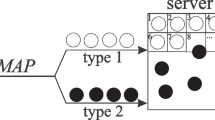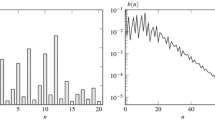Abstract
A 2-queue system with a single-server operating according to the combined ‘Join the Shortest Queue–Serve the Longest Queue’ regime is analyzed. Both cases, with or without server’s switch-over times, are investigated under the non-preemptive discipline. Instead of dealing with a state space comprised of two un-bounded dimensions, a non-conventional formulation is constructed, leading to an alternative two-dimensional state space, where only one dimension is infinite. As a result, the system is defined as a quasi birth and death process and is analyzed via both the probability generating functions method and the matrix geometric formulation. Consequently, the system’s two-dimensional probability mass function is derived, from which the system’s performance measures, such as mean queue sizes, mean sojourn times, fraction of time the server resides in each queue, correlation coefficient between the queue sizes, and the probability mass function of the difference between the queue sizes, are obtained. Extensive numerical results for various values of the system’s parameters are presented, as well as a comparison between the current non-preemptive model and its twin system of preemptive service regime. One of the conclusions is that, depending on the variability of the various parameters, the preemptive regime is not necessarily more efficient than the non-preemptive one. Finally, economic issues are discussed and numerical comparisons are presented, showing the advantages and disadvantages of each regime.






Similar content being viewed by others
References
Adan IJ, Wessels J, Zijm W (1991a) Analysis of the asymmetric shortest queue problem. Queueing Syst 8(1):1–58
Adan IJ, Wessels J, Zijm W (1991b) Analysis of the asymmetric shortest queue problem with threshold jockeying. Commun Stat Stoch Models 7(4):615–627
Adan IJ, Boxma OJ, Kapodistria S, Kulkarni VG (2016) The shorter queue polling model. Ann Oper Res 241(1–2):167–200
Armony M, Perel E, Perel N, Yechiali U (2019) Exact analysis for multiserver queueing systems with cross selling. Ann Oper Res 274(1):75–100
Artalejo JR, Gómez-Corral A (2008) Retrial queueing systems: a computational approach. Springer, Berlin
Avrachenkov K, Nain P, Yechiali U (2014) A retrial system with two input streams and two orbit queues. Queueing Syst 77(1):1–31
Boon MA, Van der Mei R, Winands EM (2011) Applications of polling systems. Surv Oper Res Manag Sci 16(2):67–82
Braverman A (2020) Steady-state analysis of the join-the-shortest-queue model in the Halfin–Whitt regime. Math Oper Res 45(3):1069–1103
Bright L, Taylor PG (1995) Calculating the equilibrium distribution in level dependent quasi-birth-and-death processes. Stoch Model 11(3):497–525
Browne S, Yechiali U (1989) Dynamic priority rules for cyclic-type queues. Adv Appl Probab 21(2):432–450
Cohen JW (1987) A two-queue, one-server model with priority for the longer queue. Queueing Syst 2(3):261–283
Cohen JW (1998) Analysis of the asymmetrical shortest two-server queueing model. Int J Stoch Anal 11(2):115–162
Conway R, Maxwell W, Miller L (2003) Theory of scheduling. Dover books on computer science series. Dover, New York
Curtiss D (1918) Recent extentions of descartes’ rule of signs. Ann Math 19:251–278
Dawson DA, Tang J, Zhao YQ et al (2019) Performance analysis of joining the shortest queue model among a large number of queues. Asia-Pac J Oper Res 36(04):1–23
Dimitriou I (2021) Analysis of the symmetric join the shortest orbit queue. Oper Res Lett 49(1):23–29
Eschenfeldt P, Gamarnik D (2018) Join the shortest queue with many servers. the heavy-traffic asymptotics. Math Oper Res 43(3):867–886
Flatto L (1989) The longer queue model. Probab Eng Inf Sci 3(4):537–559
Halfin S (1985) The shortest queue problem. J Appl Probab 22(4):865–878
Hanukov G, Yechiali U (2021) Explicit solutions for continuous-time QBD processes by using relations between matrix geometric analysis and the probability generating functions method. Probab Eng Inf Sci 35:565–580
Harchol-Balter M (2013) Performance modeling and design of computer systems: queueing theory in action. Cambridge University Press, Cambridge
Hordijk A, Koole G (1990) On the optimality of the generalized shortest queue policy. Probab Eng Inf Sci 4(4):477–487
Jolles A, Perel E, Yechiali U (2018) Alternating server with non-zero switch-over times and opposite-queue threshold-based switching policy. Perform Eval 126:22–38
Kella O, Yechiali U (1988) Priorities in m/g/1 queue with server vacations. Naval Res Logist 35(1):23–34
Knessl C, Yao H (2013) On the nonsymmetric longer queue model: joint distribution, asymptotic properties, and heavy traffic limits. Adv Oper Res. https://doi.org/10.1155/2013/680539
Latouche G, Ramaswami V (1999) Introduction to matrix analytic methods in stochastic modeling. SIAM, Philadelphia
Maguluri ST, Hajek B, Srikant R (2014) The stability of longest-queue-first scheduling with variable packet sizes. IEEE Trans Autom Control 59(8):2295–2300
Neuts MF (1981) Matrix-geometric solutions in stochastic models: an algorithmic approach. The Johns Hopkins University Press, Baltimore
Paz N, Yechiali U (2014) An M/M/1 queue in random environment with disasters. Asia-Pac J Oper Res 31(03):1450016
Pedarsani R, Walrand J (2016) Stability of multiclass queueing networks under longest-queue and longest-dominating-queue scheduling. J Appl Probab 53(2):421–433
Perel E, Yechiali U (2013a) On customers acting as servers. Asia-Pac J Oper Res 30(05):1350019
Perel N, Yechiali U (2013b) The Israeli queue with priorities. Stoch Model 29(3):353–379
Perel E, Yechiali U (2017) Two-queue polling systems with switching policy based on the queue that is not being served. Stoch Model 33(3):430–450
Perel E, Perel N, Yechiali U (2020) A polling system with “join the shortest-serve the longest’’ policy. Comput Oper Res 114:104809
Perel E, Perel N, Yechiali U (2022) A 3-queue polling system with join the shortest-serve the longest policy. Indag Math 34:1101–1120
Phung-Duc T (2017) Exact solutions for m/m/c/setup queues. Telecommun Syst 64(2):309–324
Takagi H (1986) Analysis of polling systems. MIT Press, Cambridge
van Houtum G-J, Adan IJ, Der wal J (1997) The symmetric longest queue system. Stoch Model 13(1):105–120
van Houtum G-J, Adan IJ, Wessels J, Zijm WH (2001) Performance analysis of parallel identical machines with a generalized shortest queue arrival mechanism. OR-Spektrum 23(3):411–427
Winston W (1977) Optimality of the shortest line discipline. J Appl Probab 14(1):181–189
Yao H, Knessl C (2005) On the infinite server shortest queue problem: symmetric case. Stoch Model 21(1):101–132
Yao H, Knessl C (2006) On the infinite server shortest queue problem: non-symmetric case. Queueing Syst 52(2):157–177
Yechiali U (1993) Analysis and control of polling systems. In: Donatiello L, Nelson R (eds) Performance evaluation of computer and communication systems. Springer, Berlin, pp 630–650
Author information
Authors and Affiliations
Corresponding author
Ethics declarations
Data availability statements
We do not analyze or generate any datasets, because our work proceeds within a theoretical and mathematical approach.
Conflict of interest
All authors certify that they have no affiliations with or involvement in any organization or entity with any financial interest or non-financial interest in the subject matter or materials discussed in this manuscript.
Additional information
Publisher's Note
Springer Nature remains neutral with regard to jurisdictional claims in published maps and institutional affiliations.
Rights and permissions
Springer Nature or its licensor (e.g. a society or other partner) holds exclusive rights to this article under a publishing agreement with the author(s) or other rightsholder(s); author self-archiving of the accepted manuscript version of this article is solely governed by the terms of such publishing agreement and applicable law.
About this article
Cite this article
Perel, E., Perel, N. & Yechiali, U. The non-preemptive ‘Join the Shortest Queue–Serve the Longest Queue’ service system with or without switch-over times. Math Meth Oper Res (2024). https://doi.org/10.1007/s00186-023-00848-7
Received:
Revised:
Accepted:
Published:
DOI: https://doi.org/10.1007/s00186-023-00848-7




